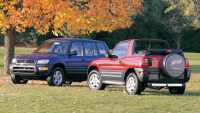I'll say at once: the popularity of this model remains a mystery to me. I don't really like grey cars and I know for a fact that there were more versatile, more driveable and more passable crossovers in their time. Why exactly the RAV4 in the second to fourth generations turned out to be the leader in popularity, I can't understand, much less explain the fact that their popularity has steadily increased over the years. It can compete in popularity only with much cheaper cars. Let's try to unravel a secret of success of RAV, and we shall begin with a body, interior, electrics and running gear. We shall speak about engines and gearboxes only in the second part.

The glorious ancestor
The very first RAV4 generation XA10 created a sensation in its time. The company produced a car that retained almost lightweight handling, but had the permeability of a good off-roader and the versatility of a minivan. Of course, it was not the first crossover in principle. Russian drivers will remember the Niva, and in the States, most likely AMC cars. But it was Toyota that was really successful; it sold millions of copies and started the "crossover boom" of the nineties.
What was the reason? Powerful promotion, successful design, readiness of the market - most likely so. The car was unequivocally extremely qualitative, the company has invested a lot of efforts in it, that is why it could sell Rav in million copies.
But cars are not eternal, and since 1994, when the first "Rafiq" appeared, a lot of water has flowed away, automakers had time to draw conclusions, to find the best solutions for themselves and niches. In the last year of the twentieth century (if who doesn't know, it is 2000), the next generation of Toyota RAV 4 XA20 was shown to the public. Actually, our story today is about it.

Technique .
The XA20 generation inherited the main features of the successful concept behind the first car. Drive could be permanent all-wheel drive, almost like the champion Celica, but it remained front-wheel drive as standard. The RAV 4 boasted independent suspensions, four-cylinder engines from 1.8 to 2.4 litres and mandatory automatic transmission for all engines (except the weakest).
 The body of this generation could be in five- or three-door versions, but the open-top design was discarded. But there was a two-litre diesel engine for European customers.
The body of this generation could be in five- or three-door versions, but the open-top design was discarded. But there was a two-litre diesel engine for European customers.
The first RAV initially had no direct competitors, so the owners put up with a simple interior, lack of options and a "sports" engine as an alternative to the base.

The car of the second generation received a dozen of competitors of different severity level, but it was not going to give up positions. To successfully fight them, RAV received a more thorough interior, improved ergonomics, greatly increased the level of passive and active safety (no secret that the first RAV4 differed not too stable handling when changing the basic tire). And the main thing is more torquey motors of 2,4 liters, which were necessary for rather heavy car. For all that, the RAV4 has remained a fairly simple car, as far as it was possible at all.
Even now, the price of such cars is still quite high. So isn't it time to find out if it makes sense to buy this car?
SUVs often suffer from corrosion at a relatively "young" age. But it practically does not concern the well-kept RAV4. Despite of good cross-country ability, it is absolutely city, or, more likely, "asphalt" car, its elements are city and suburban routes. It is not for nothing that they have refused complex four-wheel drive transmission in the next generation, having put very simple muff.
But in city conditions well protected by plastic and perfectly painted body behaves very well, at least, from outside. The only disadvantages are the corrosion of the apron under the radiator grill, the back door under the lining and unfortunate form of thresholds, because of which they are very exposed to sandblasting and gradually falling off. If not repainted in time, this area becomes riddled with rust and chips.
Fender front
Almost always trouble lurks in the area of the filler neck of the tank: dirt collects on pipes and corrosion develops.

Also in the risk zone traditionally remain rear arch and 'chrome' which often peels off.
Under the plastic covers, corrosion usually develops slowly, mainly in the clip areas of fasteners and at the points of contact of plastic with the body. The attachment points for the tailgate linings and sills are particularly vulnerable. Caring owners usually protect these areas, but unfortunately, neglected examples can also occur.
Water in the boot is a typical nuisance, so the tailgate and lantern seals should be changed regularly and the lock adjusted. But if the hinges on that door are rusty and in poor condition, none of this will help and you'll have to replace them. And don't wait too long: in neglected cases, leaks can lead to corrosion and problems with the rear car's electrical system.
Pictured: Toyota RAV4 5-door '2000-03
Pictured: Toyota RAV4 5-door '2000-03
There is water in the cabin almost always. The problem is in the grommet of the wiring harness of the engine compartment. If the plug is a little bit dry, water from windshield goes straight on wiring harness, through it - into interior. It dries out usually after three-five years of exploitation in our climate. Its greasing helps a little, but it is better to apply grease in bellows and to "siliconize" all harnesses on the way.
All these reasons cause that, unfortunately, floor under driver's feet has already got corrosion marks and even with holes. Moreover, the whole "bath" up to the rear couch mounting hinges, including seams of lateral reinforcing and longitudinal cushioning of threshold. Then, because of moisture absorption into cardboard "noise", corrosion develops along a zone of central tunnel.
Front bumper
What can we advise? Touch the floor carpet, and if it's damp, try to remove it. An indirect sign of serious problems in this area are the rusty bolts fixing the front seats. Fortunately, this is the only weak spot in the bodywork.
Unfortunately, Toyota is often bought by people who want to drive and don't want to invest in maintenance or just look after the car. If the car has not been washed or cleaned after serious dirt trips, chances are that you'll easily find a lot of small pockets of corrosion, and in some places quite serious damage is hiding. This is compounded by the relatively thin body panels. It's a short cut (or rather, a couple of years) from blistering of paintwork to penetrating corrosion.
Damage on wings and doors should be repaired as soon as you notice it. And don't be lazy to bend plastic linings and wash out mud in the joints between a fender and a headlamp.
Note the bolts on the strut supports and ABS bracket. On a "glasses" in engine compartment even a little corrosion inside says that a big part of metal has already turned to dust on a side of wheel arch, and restoration will cost a lot of money.
The imported "American" RAV4 has worsened the statistics. There are a lot of them in our market, in "low dollar" years such cars were imported in large quantities. Their anticorrosive coating is noticeably worse than European cars, and they need regular treatment of inner cavities of the body. Anyway, it will not harm "our" cars either.
At a purchase it is necessary to examine a body for "off-road" damages: chafed underbody, torn bumpers' fastenings, dents on details of suspension. And, of course, check sill seams underneath, especially at the rear. If the seams are loose and swollen, it is likely that there is dirt inside the sill and, as a consequence, there is already serious rust.
Pay attention to the side members and the rear arch mudguard, which are also the first to show signs of former off-roading and badly washed bodywork.
If the interior smells of petrol, the fuel tank may have rotted after off-road trips. If dirt gets on its upper part, it causes corrosion, which easily leads to holes in tank and bodywork. It's tricky to wash, but you can: remove the access hatch to the fuel pump in the passenger compartment and you can clean the cavity with a kerger with an angled nozzle. Better yet, just make sure it's clean.
Muddy yellowing headlights are a characteristic feature of the RAV4, so don't be surprised if the optics have been replaced before sale with "fresh" one.
Pictured: Toyota RAV4 5-door '2000-03
In the photo: Toyota RAV4 5-door '2000-03
RAV4 has soft windshield, and it cracks easily as a result of improper use of climate control system. With mileage up to a hundred thousand miles you could still find these elements in excellent condition, but now the whole glass indicates either extremely careful use or careful preparation for sale.
It is not necessary to speak about such trifles as rusty wiper blades, it is usual for ten-year old car. But the stuck mechanism of a mechanism of a wiper of a back door and leaks of washer systems meet regularly, and it's not a trifle.
Novye-Zaglushki-Bu-1
Interior
An interior meets a driver with abundance of rigid plastic and small creaks and knocks. However, they are badly noticeable on a background of weak noise isolation. But if to keep windows open, you will not hear crickets at all.
In the photo: Interior of Toyota RAV4 3-door '2000-03
In photo: Interior of Toyota RAV4 3-door '2000-03
The number of cars with additional noise insulation is rather large: not many people wanted to put up with discomfort on rough asphalt and on winter tires. In many respects it is a plus, because at the same time it was possible to remove a leak in driver's legs in time, and to damage something with installation of sound insulation is difficult here: it's very easy to disassemble and assemble Rava interior.
From the typical failures we shall mention dangling control unit of windows, weak door locks (especially back), backlash of buttons on the left side of the panel and rusty coating of a steering wheel and all "contact surfaces". Moreover, even in cars without leather upholstery.
In photo: Torpedo of Toyota RAV4 5-door '2000-03
Photo: Top compartment of Toyota RAV4 5-door '2000-03
The heater radiator is often clogged in older cars, which haven't changed antifreeze in time or, what's worse, were filled with different sealants in cooling system to prevent leakage of the pump or radiators. Unfortunately, this nuisance is also typical.
A weak multimedia system is not to be considered as a breakage, but one should be ready, that it does not provide neither normal navigation, nor decent sound. It is good that at least it is located successfully, it can be replaced by a modern two-dial system with the minimum of additional expenses.
Otherwise, the complaints are only about materials and ergonomics. The car is much more comfortable than the first generation, but it is not friendly to tall passengers: it has not enough range of front seats' lengthwise adjustment, a steering wheel is regulated only by the angle of inclination, a seat cushion is rather short. And the form of seats, frankly speaking, is not convenient for travel on long distances. In general, it is far from TLC.
It seems to be the basic complaint as everything else is very, very good for the old car.
Novye-Zaglushki-Bu-2
Electrics
If a boot and a saloon are dry, and there have been no large-scale measures of repair or replacement of the engine under a cowl, the RAV4 electrics do not show themselves practically in any way.
On cars with high mileage the driver's door wiring is likely to be "glitchy": the harness will break there little by little.
The alternator usually will not withstand more than 150-200 thousand kilometres, it will need replacement of slip-rings and bearings, but it's not a bad result.
The radiator fans live a little longer even in the city mode, and if you drive on the highway, they are eternal.
Small capacity of regular battery also causes quite a few problems, many are superstitiously afraid to put higher capacity battery, being afraid of mythical undercharging, which seriously complicates your life: motors on RAV4 badly start in cold weather, and the load on the generator with small capacity battery increases.
During long starts, the starter retractor relay also gets burnt, and burnt-out starters are not uncommon.
Failures in the locks can be caused by limit switches within them and in the wiring.
Otherwise, there are almost no difficulties with electric stuffing of a car, except that lambda- and other sensors in a motor compartment need regular replacement. Nevertheless, we mustn't forget, that cars are already quite decent in age, so it's worth checking everything, especially if there are out-of-stock "music" and alarm system.




